I want to say that there are scams in the crypto space, but it's not to say that the crypto space is a scam. Everyone's perspective on things is different, just like tastes, there are thousands of tastes. Just like love, people who are doing well will say they are happy, but most people who are not doing well will say, don't easily try marriage and love! It depends on the kind of people you come into contact with, and the rest is personal opinion! Today I will share my trading tactics and insights with crypto friends. There is a saying that standing on the shoulders of giants will save you ten years of struggle. I will also talk to you about the most important profit system. Friends who are destined to see this and want to improve their cryptocurrency trading level must read it carefully and study it carefully. It is recommended to save it!

Profiting is about sticking with the trend-following orders that others give up, taking the opportunities that others don't want and grasping them for yourself, and doing things that others don't dare to do. Investment only has abandoned persistence, not complete failure. Trading is the same. Originally, you were optimistic about a direction, but as the market fluctuated, you changed your original direction. You were originally bearish, but because the market rose a little, you got out and went long, which ultimately delayed the downtrend and caused losses against the trend. There are countless examples of this in trading. Any success requires persistence.
Becoming a highly defensively-minded trader is a crucial transformation for novice traders in their trading journey. Many beginners may be misled by a get-rich-quick mentality, hoping to make profits as soon as possible, even with a "get rich overnight" mindset. However, a more practical and feasible mindset should be: maximizing the protection of one's capital. These two mindsets cannot coexist. If you only focus on making quick profits, it is likely that your capital will be lost even faster.
A rule in the sports arena also applies to trading: offense is the best defense. In this context, it means only trading under favorable conditions and protecting capital at other times, staying away from the market. Novices may be lucky enough to succeed in the first few trades, but luck cannot last. You should be wary of the "beginner effect" trap.
Imagine that if you have a gun, you will not easily waste bullets unless you are absolutely sure that you can accurately hit your prey. The same principle applies to trading. Retain your capital and only deliver a "fatal blow" when a truly favorable opportunity arises. In trading, maximizing the protection of capital is the key to success. As long as you can effectively control the risk, even if you encounter a strong entry signal but ultimately fail, the impact on your capital will be controlled within a reasonable range.
Frequent viewing of charts and constant monitoring of trades can often have a negative impact on trading. In life, too much interference usually does not have good results. If you are always trying to over-control the trade, the result may be counterproductive and bring you more trouble.
Have you ever unconsciously added to your position or exited a trade early because you were too focused on the chart? Looking back, do you feel that you were too impulsive at the time? This kind of unplanned behavior is often one of the reasons why many people lose money.
The easiest way is to set up a trading plan and then forget about it. This is a principle I often emphasize to novices, and it is also one of the most valuable lessons I have learned: in trading, the less you interfere with the operation, the better. Simply follow your trading plan and let the trade proceed as planned, that is true trading wisdom.
The result of the previous transaction should not affect the next transaction. The result of the previous transaction should not affect the next transaction. This is an extremely important principle, but many people often forget it. They are easily swayed by the results of the previous transaction. However, it needs to be understood that each transaction is unique, and transactions
The results are randomly distributed. Suppose you make 100 trades, the profits and losses may be similar. However, their distribution cannot be so even. There may be 5 or 10 consecutive losses, and if these losses affect your mentality, then the potential profit opportunities that may appear next will also be hindered by your emotional state.
It is also important to note that after a profitable trade, excessive confidence can have as negative an impact on trading as the fear after a losing trade. Overconfidence can make people more willing to take excessive risks, and its negative impact is quite terrible in the long run. Therefore, staying calm in trading and not being swayed by short-term trading results is the key to maintaining a stable mindset and achieving long-term success.
Simplify trading, you will gain more.
In trading, moderation is key. A common mistake that many traders make is doing too much. They over-analyze the market, over-interpret the market, overthink and over-order operations. Overall, they do many unnecessary things. As a trader, learning to be appropriately "lazy" is also important.
First of all, it needs to be clear that the favorable signals that appear in the market over a period of time are limited, or even very few. Most of what you see and hear may just be "market interference", which is noise and does not benefit you. Learning to filter these signals and then filter out the "high-quality signals" that are truly beneficial to you is a normal step in finding opportunities.
Secondly, I suggest that you learn the mentality of hedge fund traders to trade. They hold millions of dollars or even hundreds of millions of dollars in funds, but they trade very methodically, like picking diamonds in the sand, only choosing the opportunities with the highest returns. For those ambiguous signals such as "possible" or "seems", I advise you to stay away. In my 20 years of trading experience, the best trades are always the most obvious and intuitive.
Before entering, have a clear exit plan.
In trading, no one tells you what to do. You have to make your own rules, which means you have to be responsible for your actions. Many people lack this self-control, which often leads to losing their trading direction.
Before trading, one of the most important tasks is to determine an exit plan. It took me years to realize that exiting is more important than entering. I observed that many people's exits are arbitrary, resulting in either very little profit or a large loss. Establishing a strict profit and loss plan is the best way. Such a plan can provide you with clear guidance, allowing you to remain calm and execute the plan whether in profit or loss. This disciplined exit plan helps ensure that you maintain a clear head in trading and reduce the impact of impulsiveness and emotions on decision-making.
Avoid valueless transactions
In the world of trading, valueless trading refers to trades where the risk and profit are disproportionate, usually occurring in a state of blind and frequent trading by the trader. This type of trading often leads to losses greater than profits, affecting the trader's mentality and even trapping them in a vicious cycle of losses.
Specifically, when facing volatile markets, traders can't wait to enter the market when they see so-called "opportunities," without considering the profit and risk of the trade. Traders who blindly enter the market usually have a fluke mentality, thinking that even a small profit is still a profit. They turn a blind eye to small profits and great risks, and even think that any market is an opportunity not to be missed, subjectively amplifying small opportunities and impulsively trading. This attitude not only shows contempt and disrespect for the market, but also makes it difficult to achieve good results in the market.
For professional traders, they usually pre-set trading plans, set stop losses, etc., to ensure that even if there are losses, they will not have too much impact. However, the losses brought about by valueless transactions are different, because these traders have a shallow understanding of the market, their trading decisions are more casual, and they lack careful consideration. This avoidable loss is more harmful than beneficial to the growth of traders.
High Discipline
High discipline plays a vital role in financial market trading. It refers to a trader following a set of clear rules and principles when trading to ensure effective risk management, achieve investment goals, and avoid adverse consequences caused by emotions and random decisions. The level of discipline is directly related to the success or failure of trading and is considered one of the key factors for successful trading.
I insist on emphasizing non-interference in trading decisions. Every day I spend only half an hour checking charts, deliberately avoiding getting caught up in over-observation
market volatility. I advise traders to strictly adhere to trading plans,
Avoid over-analyzing the market, because disciplined execution is the cornerstone of stable profitability. By following a predetermined plan, I am able to remain calm and avoid emotional decisions, thereby improving the efficiency and stability of trading.
Most of the time, you should stay away from the trading desk. A wise strategy on the road to trading is to keep your distance from the market. Over-trading is often a shortcut to losing money, and it's crucial to remember this!
In price action trading, understanding candlestick patterns is one of the most important foundations for chart reading. These candlestick patterns provide visual clues to help traders predict market movements. One of the most powerful and common patterns is the Pinbar. In this article, we will delve into what a Pinbar pattern is, how to identify it, and most importantly, how to trade it effectively.
Structure of Pinbar Candlestick Charts
To truly understand the power of the Pinbar, you need to carefully dissect its construction. A typical Pinbar contains three main components:
1. Long Shadow (Long Upper/Lower Shadow): The shadow is the most prominent feature of a Pinbar. It shows the price level that the market has rejected. In a bullish Pinbar, this long shadow is below; in a bearish Pinbar, it is above.
2. Small Body: The body of the Pinbar, i.e., the part between the open and close, is very small relative to the shadow. This small body is crucial because it indicates that buyers and sellers did not reach an agreement at the extreme price levels tested by the shadow.
3. Extremely Short Shadow on the Other End: The shadow on the other end should be much shorter, or may not even exist, which further emphasizes the dominance of price rejection represented by the long shadow.
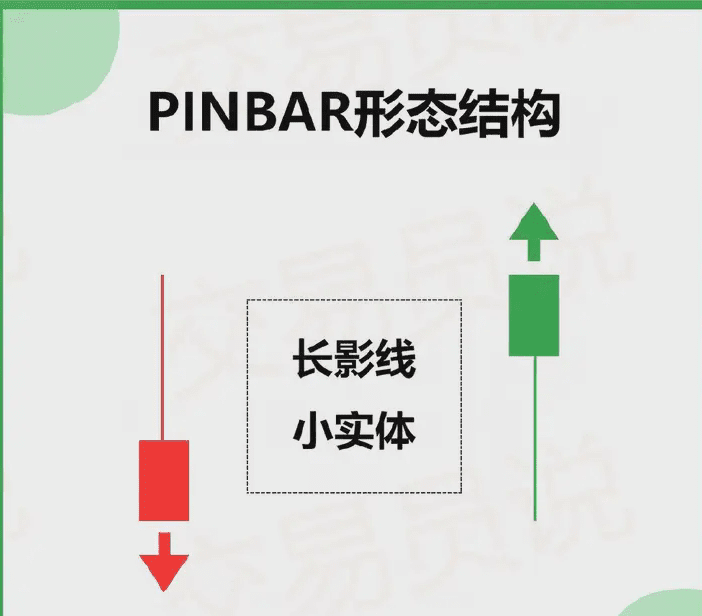
The trading psychology behind Pinbars is simple: It's a battle between buyers and sellers, in which one side once controlled the situation but ultimately failed, leading to a sharp price reversal. This unsustainable control creates a strong trading signal: prices tend to move away from the direction of the long shadow and towards the direction indicated by the body.
Interpretation of Pinbar Candlestick Patterns
The Pinbar pattern is a single candlestick pattern characterized by: a long shadow at one end, a small body, and a very short shadow (or no shadow at all) at the other end, looking like a "pin." This long shadow indicates that the market has tested a certain price level but was quickly rejected, causing the price to retrace. It is this "rejection shadow" that makes the Pinbar a powerful signal in trading.
Pinbars can be bullish or bearish, depending on where they form and the direction of the market.
◔ Bullish Pinbar: Has a long lower shadow, usually appears in a downtrend, indicating that sellers tried to push the price further down but failed, thus predicting a possible upward reversal.
◔ Bearish Pinbar: Has a long upper shadow, usually appears in an uptrend, indicating that buyers tried to push the price higher but were rejected, thus suggesting a possible downward reversal.

A deep, private event truly built for traders is coming! The Chengdu stop of the Trader Says Elite Member Private Event on July 12th is open for free registration - valuable content, no hidden fees. Top trading mentors will share their insights and reveal high-win-rate strategies and risk management techniques. Attendees will have the opportunity to receive signed books, SMC courses, and mentoring qualifications. Enjoy refreshments and network to expand your connections. Seize this opportunity to completely upgrade your trading system and register now by scanning the QR code!
How to Identify Pinbar Patterns on Charts
Once you've grasped the key points, identifying Pinbar candlestick patterns on charts is relatively simple. Here are the main criteria for judging:
⊙ Shadow Length: The long shadow must be at least two-thirds of the entire candlestick length. This means that the longer the shadow relative to the body, the stronger the signal.
⊙ Body Position: The body of the Pinbar should be located at one end of the candlestick. For a bullish Pinbar, the body should be near the top of the candlestick; for a bearish Pinbar, the body should be near the bottom of the candlestick.
⊙ Market Context: An effective Pinbar should appear at a key location on the chart, such as a support level, resistance level, trend line, or moving average. This context is crucial for determining the reliability of the Pinbar as a trading signal.
Pinbars work better on higher time frames (e.g., daily or weekly charts), but can also be used on lower time frames such as hourly or 4-hour charts. The key is to ensure that the market context supports the signal emitted by the Pinbar.
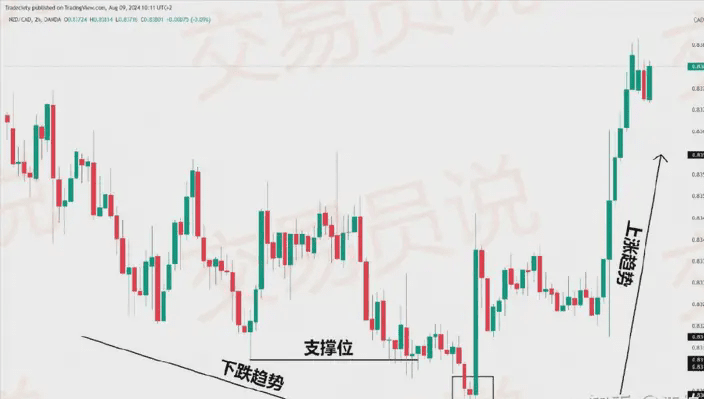
Interpreting Pinbar Candlestick Charts
Once you've identified a Pinbar, the next step is to interpret what it means for your trading. This interpretation depends on whether the Pinbar is bullish or bearish.
Interpretation of Bullish Pinbars: A bullish Pinbar indicates that the downtrend may be ending and buyers are starting to enter the market. This type of Pinbar usually appears at the bottom of a downtrend or at a key support level. When you see a bullish Pinbar, it is a signal that the market may reverse upwards.
For example, suppose you are analyzing a stock that is in a downtrend and a bullish Pinbar suddenly forms at a strong support level. This Pinbar indicates that sellers tried to push the price further down, but buyers intervened strongly, rejecting the lower price and pulling the price back up. This may be a signal to consider a long position (as a reversal trading strategy), while setting a stop-loss order below the low of the Pinbar.
Interpretation of Bearish Pinbars: On the other hand, bearish Pinbars indicate that the price may fall back down. It usually appears at the top of an uptrend or near a resistance level. This Pinbar indicates that buyers tried to push the price higher, but encountered strong selling pressure, causing the price to fall back.
For example, you are watching a stock that is in an uptrend. A bearish Pinbar forms near a major resistance level or a similar "triple top" pattern. This Pinbar indicates that the uptrend may be losing momentum and sellers are starting to take control. In this case, you might consider establishing a short position and placing a stop-loss order above the high of the Pinbar.
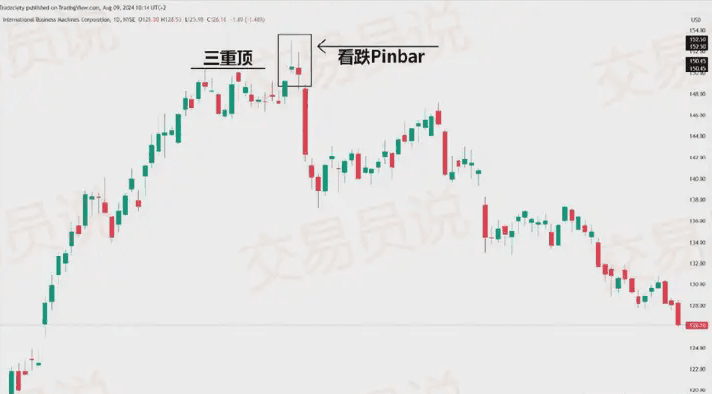
Trading Strategies Using Pinbars
Pinbars are very flexible and can be used in a variety of trading strategies. Here are two common and practical Pinbar pattern strategies:
1. Trend Continuation Strategy
In a trend continuation strategy, the Pinbar is used to confirm that an existing trend is likely to continue. For example, in an uptrend, you can look for bullish Pinbars that form during pullbacks. These Pinbars indicate that the pullback may be over and the main trend is expected to resume.
Example Trading Plan:
⊙ Observe "higher highs and higher lows" to confirm an upward trend.
⊙ Wait for a pullback in the trend to occur.
⊙ Look for bullish Pinbars forming at key support levels, trend lines, or moving averages.
⊙ Enter long after the Pinbar closes, placing a stop-loss order below the low of the Pinbar.
⊙ The target price can be set at the previous high or key resistance level.
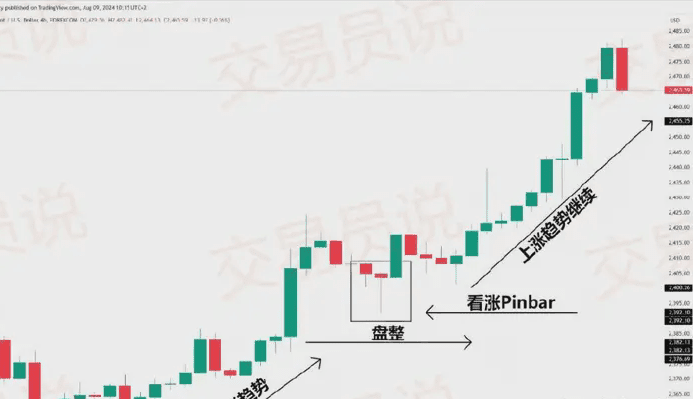
2. Reversal Strategy
The reversal strategy is based on the idea that Pinbars can signal the end of a trend and the start of a reversal. This strategy is particularly effective near key support or resistance levels.
Example Trading Plan:
⊙ Observe "lower highs and lower lows" to confirm a downward trend.
⊙ Pay attention to bullish Pinbars formed at important support levels.
⊙ Enter long after the Pinbar closes, placing a stop-loss order below the low of the Pinbar.
⊙ The target price can be set at the next resistance level or Fibonacci retracement level.
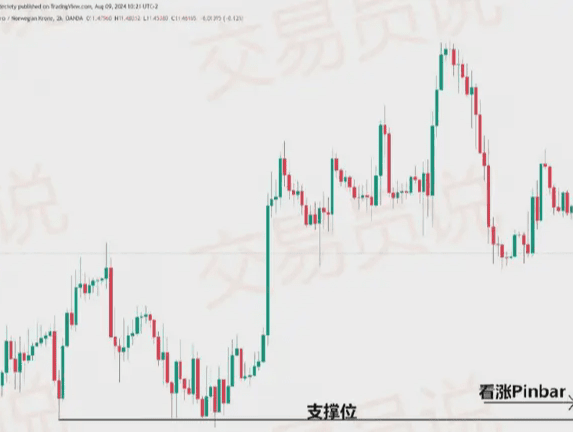
Combining Pinbars with other technical indicators (such as moving averages, RSI, Fibonacci levels, etc.) can increase the probability of successful trades.
Common Mistakes and How to Avoid Them
While the Pinbar is a powerful tool, it is not foolproof. Here are some common mistakes traders make when using Pinbars, and how to avoid them:
1. Misjudging Pinbars: Not all candlesticks with long shadows are Pinbars. Be sure to confirm that the candlestick meets the specific criteria for a Pinbar before trading. In addition, the context in which the Pinbar forms is also very important. If a Pinbar appears in the middle of a trend and there are no significant support or resistance levels nearby, its signal is often unreliable.
2. Over-reliance on Pinbar trading: Relying solely on Pinbars to make trading decisions can lead to over-trading and poor results. Before entering a trade, you must consider other factors, such as the overall market environment, other technical indicators, and risk management strategies.
Conclusion
The Pinbar pattern is a very powerful tool in the trader's toolbox. Whether you want to take advantage of trend continuation or capture trend reversals, understanding how to identify and trade Pinbars can significantly enhance your trading strategy. However, like all trading tools, Pinbars should be used in conjunction with other analysis and indicators for maximum effect.
By mastering the Pinbar pattern and incorporating it into your trading plan, you can improve your ability to predict market movements and make more informed trading decisions.
Remember, practice and experience are essential - before live trading, be sure to take the time to backtest strategies and optimize your trading methods. Good luck with your trading!
Opportunity knocks, double your assets! Follow Brother Cheng and make big money easily.
Keep Following: SPK,SAHARA



